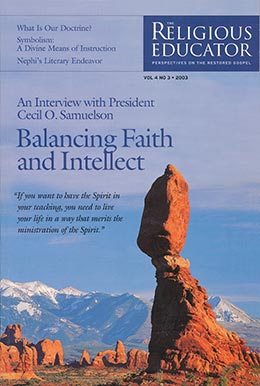Tips for Using the Scriptures on Computer
John P. Livingstone
John P. Livingstone, "Tips for Using the Scriptures on Computer," Religious Educator 4, no. 3 (2003): 123–131.
John P. Livingstone was an associate professor of Church history and doctrine at BYU when this was written.
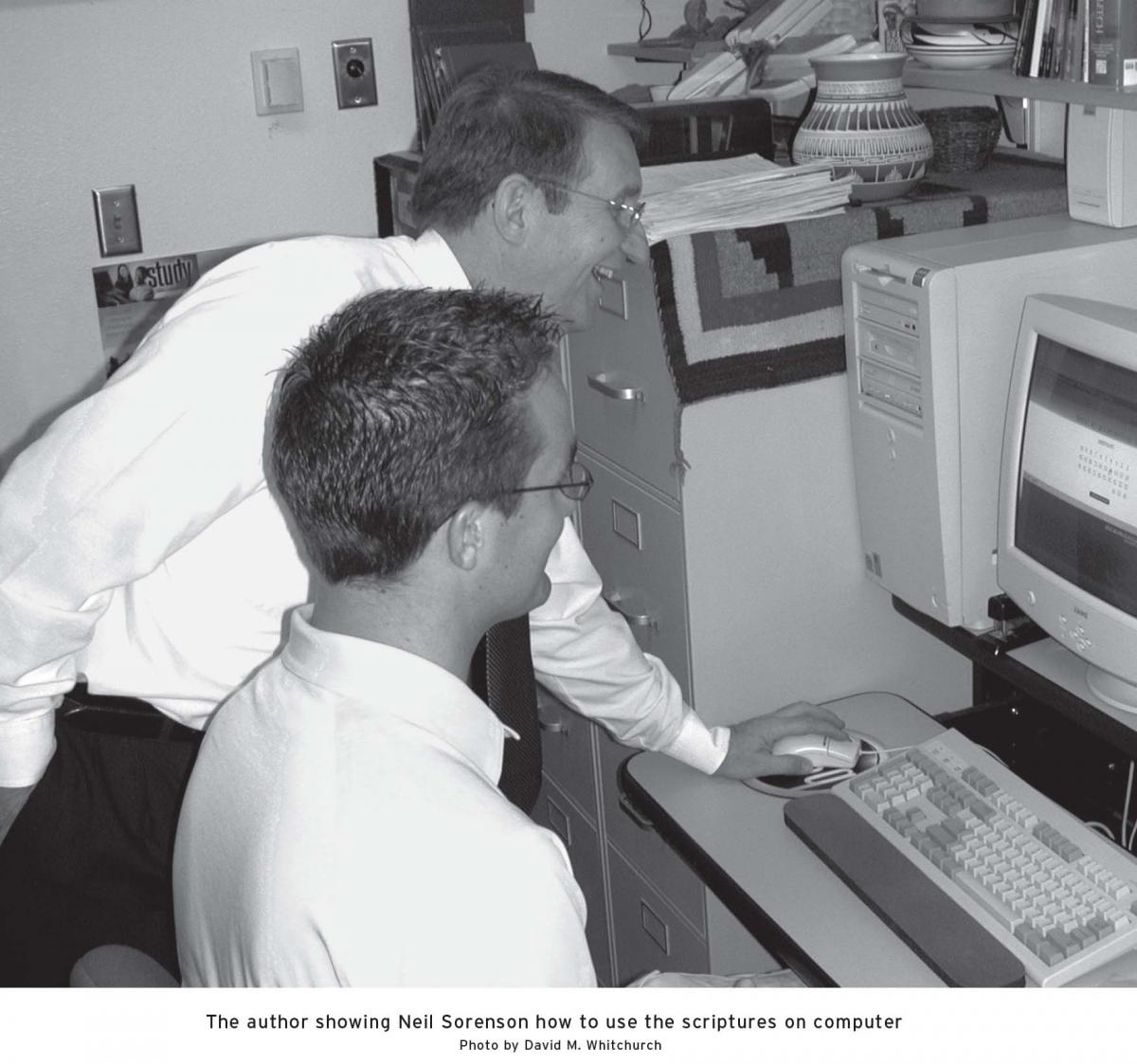 The author showing Neil Sorenson how to use the scriptures on computer. Photo by David M. Whitchurch.
The author showing Neil Sorenson how to use the scriptures on computer. Photo by David M. Whitchurch.
Computers are powerful tools. And while educational tools can enhance delivery, a well-prepared teacher is still at the heart of gospel learning. Understanding doctrine and teaching by the Spirit remain essential. But using the inspired advances in the technology we have been given is a way to act responsibly toward the bestowed blessings. Computers put many resources at our fingertips that previously required much more time, planning, materials, and effort. Scriptures, teacher manuals, student manuals, pictures, audio clips, videos, and other teaching objects can all be accessed in seconds.
How can a teacher begin to use the most powerful computer resources to teach the gospel and begin to help students this way? This short article provides a quick tour through the computerized scriptures, showing how to access these marvelous resources and offering useful tips for teachers and students alike.
A teacher with access to a computer projector, or even just a monitor for more intimate settings, can focus all students’ attention at once. Even students who seem to always sit with their scriptures closed will, at the very least, be looking at the verses on the screen. Just as bookworms are more likely to read the scriptures on paper, budding technophyles will find more interest in computer scriptures simply because of the medium being used. Some have asked, “Do your students still bring their scriptures to class?” The answer is yes. They bring them and mark them and spend more time in the scriptures than they used to. The ability to click on words with superscripts (indicating footnotes) and cross-references and immediately see the related footnotes pop up at the bottom of the screen makes searching the scriptures much faster. One developer said this new scripture-searching capacity can be compared to flying across the American plains as opposed to walking. You get to the same place in the end; it’s just faster this way. You have only so many fingers to keep track of verses you have found in the paper edition of the scriptures; but with the computer, you can go forward or backward through multiple screens and review the scriptures with significant economy of time (and fingers). And without losing your place you can click backward and forward through screens to find that scripture you looked at a few minutes ago. Teachers can read the scripture blocks and prepare their lessons by importing scripture verses, maps, or pictures into word processing or presentation software (like Microsoft PowerPoint) that can be saved on their computers or posted to a Web site that they or their students may view during class or afterward. Let us look at the two different computer scripture editions and benefits of each.
The Scriptures: Internet Version
The official Internet version of the scriptures comes up when you visit www.lds.org and click on the word “Scriptures.” You then see the title page, which looks like this:
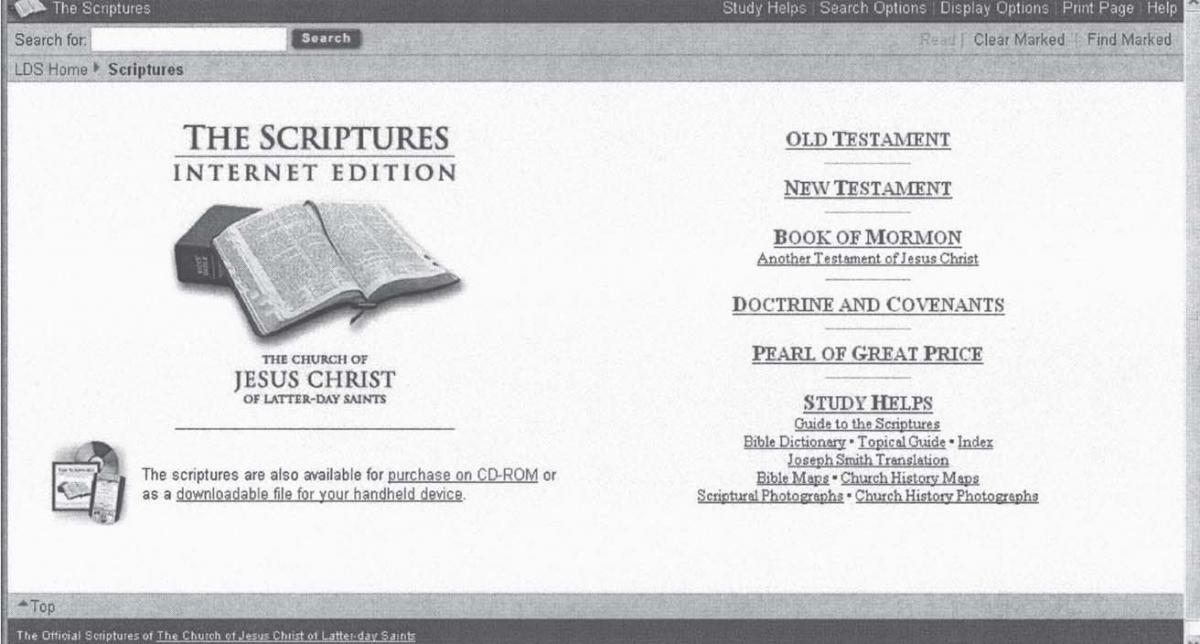
Click the left mouse button on any of the titles to take you to the standard work selected. You may then click on the book and chapter and begin reading or copying the verses (a good way to prevent errors when preparing a talk or lesson). Or you may type a full or abbreviated reference (such as “1 Ne. 3:7”) directly into the “Search for” box in the top left-hand corner of any page, and a stand-alone copy of the verse will be displayed with its footnotes, like this:
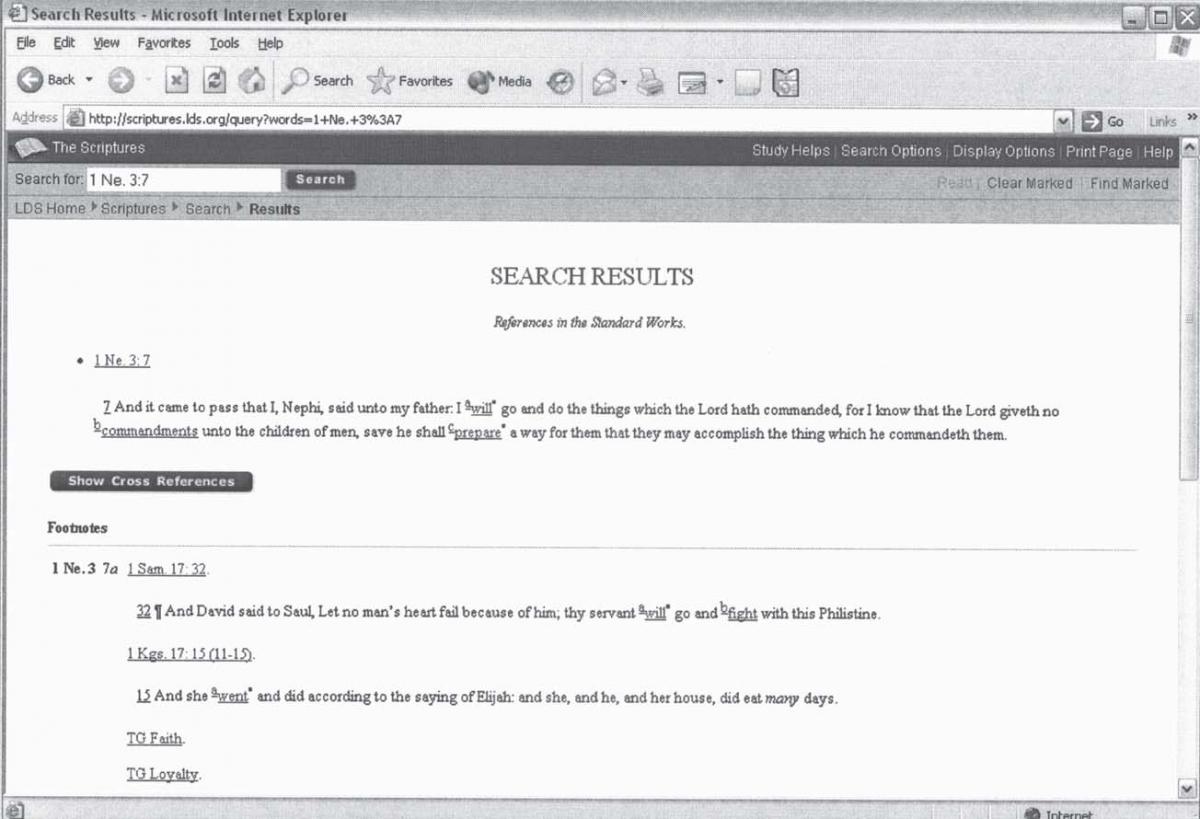
Notice that each footnote comes with complete scripture verses rather than just the reference.
Notice that all the words in the verse that have tiny superscripts are hyperlinks. Clicking on any of those words will take you to another screen that will again show the verse standing alone, as above, with the associated footnote. There are over half a million hyperlinks in the Internet scriptures. Pointing and clicking on “Show Cross References” will show cross-references for that verse from the footnotes, Guide to the Scriptures, Topical Guide, Index to the triple combination, Bible Dictionary, photographs, and maps.
Reading scripture online, with the ability to quickly follow interesting links, is fast becoming a means for deep scripture study. And individuals who are using electronic scriptures are learning the terrific benefits of the study helps. It is possible to open multiple windows simultaneously. This way, anyone can view a map or another book of scripture in one window while reading a particular chapter in another, making comparative scripture study easy and quick.
Clicking on the bulleted reference at the upper left will show the verse highlighted in its full context within the chapter in which it is found, as shown in the next figure:
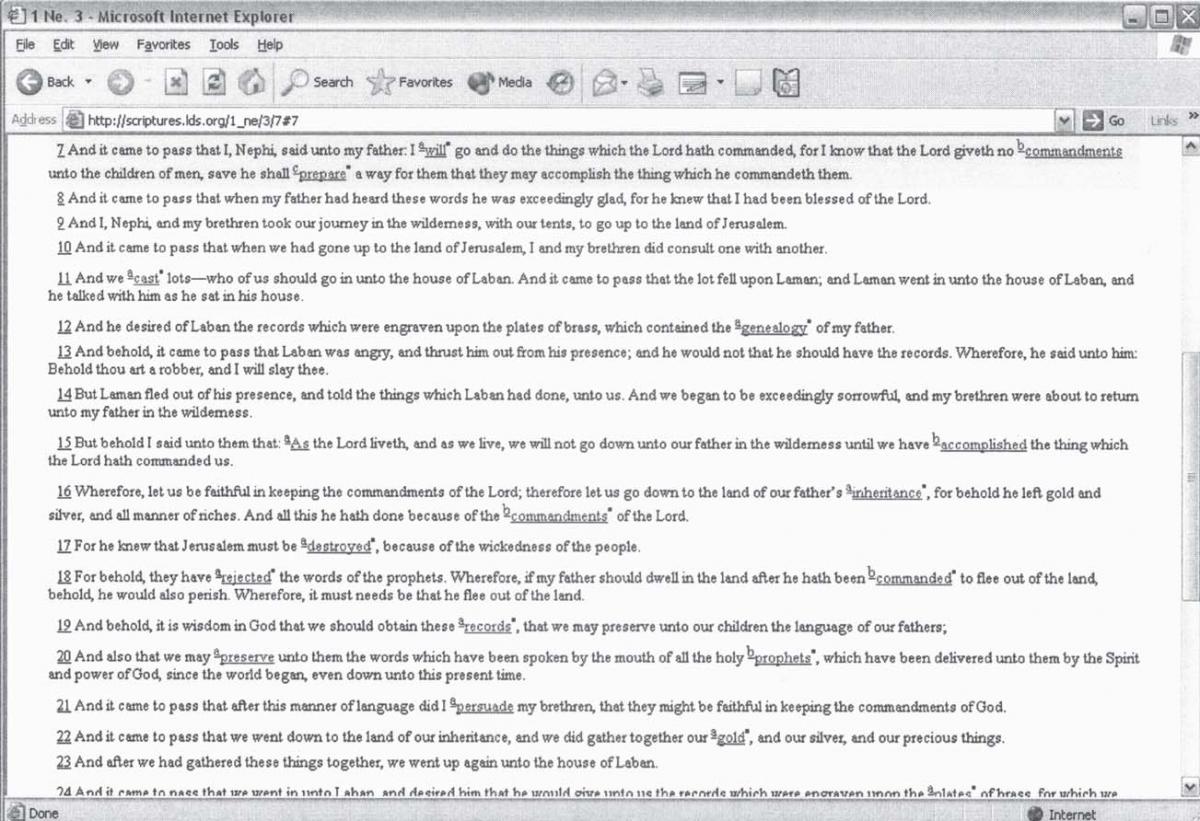
Included in this version is the ability to download the standard works to a handheld device such as a Palm Pilot or HandSpring Visor. You have likely seen these in Church meetings as individuals gently poke their little screens with a pencil-like stylus while speakers and teachers quote scripture references. The speed of the computer scriptures is such that, with a little experience, you can usually bring up the scripture being cited in a meeting or class before it has been fully quoted. Many find this faster than turning pages in their bound scriptures. One limitation of the Internet scriptures at present is that you may mark only fifty scripture verses at a time, and then the marking is only temporary.
With more and more teachers and professors posting their class information on the Internet and with more and more resources for learning being added to the Web, students are becoming highly effective searchers and studiers in this medium. We can teach students to include scripture study in their surfing of the Web and to know where to go for gospel resources from Church-authorized sites. Even now, the Internet scriptures are fast becoming one of the most visited sites in the world, with a million hits recorded every three or four days.
The Scriptures: CD-ROM Version
There are two CD versions of these computerized scriptures: The Standard Edition 1.0 and the Resource Edition 1.0. The Resource Edition contains all that the Standard Edition does plus several additional languages (such as Greek and Hebrew) that may be viewed in parallel columns. It also has the capacity to mark any text with personal notes and a choice of colored highlighters. Additional dictionaries and concordances are included.
In order to access either of the CD-ROM scriptures, of course, one must have at least a 4X compact disc player in their computer, which is much more common today than even a few years ago. Windows 95 or newer is necessary and about 250 MB of hard disk space is required if you wish to load all data and programs. Only 50 MB is needed if one wishes to run the scriptures from the CD in the disc player rather than the hard drive. Multiple languages are available (English, French Italian, Portuguese and Spanish) in this version. Again, everything found in the bound scriptures is found in this version. Once loaded onto a computer, one simply clicks on the appropriate icon, and up come the scriptures. The opening screen looks like this:
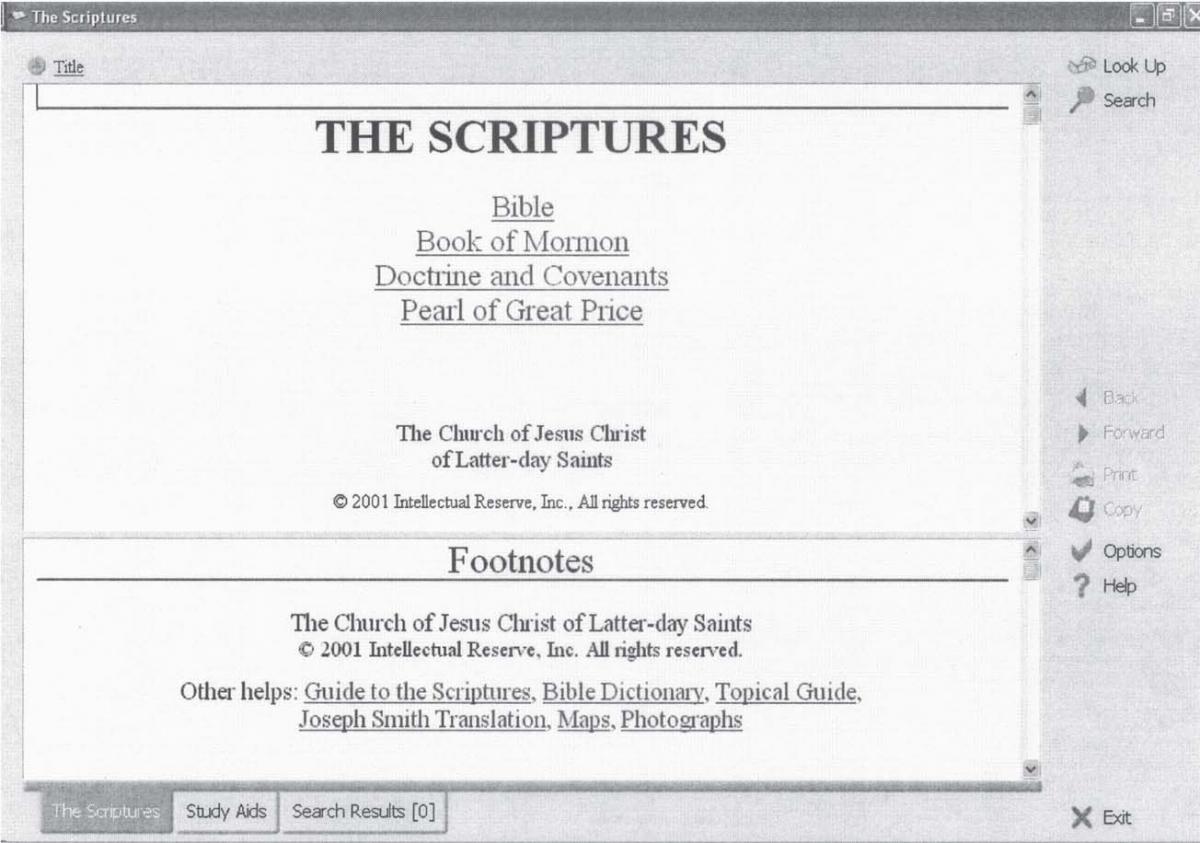
Like the Internet version of the scriptures, this version also allows users to click on the book title to go directly to the text. You can set software preferences to have footnotes appear simultaneously with scripture, as shown, or not. One significant advantage of the newest version of the CD scriptures is that you may mark verses, using a variety of color highlighters. You simply block the text and click on the highlighter icon, choose a color, and add a note if you would like. Clicking on the highlighter/
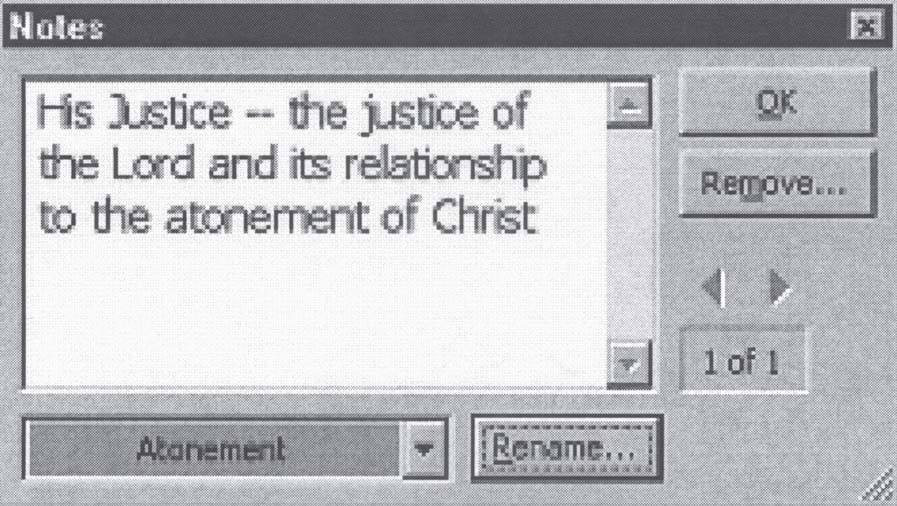
You can choose the color and add text to your note, as shown.
Scriptural Help for Personal Problems
Computer scriptures are a very powerful tool for helping solve personal problems. I have pointed out to students that the English Latter-day Saint scriptures have a Topical Guide containing words and phrases that can direct us to scriptures that offer solutions to problems that vex our lives. Translations of the scriptures in other languages include the Guide to the Scriptures in place of the Topical Guide. The computer scriptures in English have both. Our modern pace of life has many people feeling particularly lonely and insecure. Perhaps just being mortal means that we yearn for the spiritual security and love we left behind at birth. Perhaps all of us have stood before an open refrigerator late in the evening feeling hungry, but nothing looked good. That hungry-and-not-satisfied feeling is what an addict wrestles with. In an attempt to satisfy this spiritual yearning or hunger, individuals often reach out to substances and events they hope can bring comfort and peace. Substances ranging from nicotine to heroin and activities ranging from spending to pornography, masturbation, and other sexual perversions are used in a vain attempt to find some kind of solace. Over time, nothing will do for one addicted to such things except to reach out for the very thing that makes them hate themselves afterward. They know they should not do it, but their natural body and brain have come to the conclusion that it is the only thing that seems to work to deal with the hunger. The trouble is, it only works for a little while, and the guilt is cumulative, blocking the desired pleasure. Coarser and deeper addictive behavior results, “and then they are taken captive by the devil, and led by his will down to destruction. Now this is what is meant by the chains of hell” (Alma 12:11). Ironically, the hunger is not physical at all. It is spiritual. It is a yearning, a deep gnawing desire for comfort, peace, and spiritual security. When we feel the yearning cannot be satisfied, we are depressed. It is like the situation Isaiah described: “When an hungry man dreameth, and, behold, he eateth; but he awaketh, and his soul is empty: or as when a thirsty man dreameth, and, behold, he drinketh; but he awaketh, and, behold, he is faint, and his soul hath appetite” (Isaiah 29:8). Yet only spiritual food will satisfy a spiritual hunger.
I encourage students to look up in the Topical Guide or Guide to the Scriptures words and phrases that represent how they feel or things they are worried about. Searching for the opposites of these words and phrases can also be very instructive. For instance, those who are struggling with a habit or addiction that is impairing their lives would do well to go to “Bondage, Spiritual” and scroll down the scripture list looking for words and phrases that seem to stand out. I invite them to turn to their scriptures and read a few verses before as well as a few verses after the phrase cited in the Topical Guide. I also encourage them to watch for superscripts or hyperlinks that take them to related ideas and solutions in other locations in the scriptures.
Perhaps all of us have an addictive potential of some sort and can relate to some of the citations above. Using the Topical Guide in electronic scriptures to click through a search for answers to issues has helped many individuals not only to glean intellectual resources for problem solving but also to find soul-satisfying spiritual promptings. It seems that the very process of reading and searching scripture for solutions brings a deeply spiritual response that invites resolution on a basic level that may even be deeper and more productive than an otherwise intensely intimate conversation with a highly capable and sensitive therapist. Somehow, penetrating spiritual processes that convince and persuade beyond normal therapeutic capacity seem to follow. Helpful topics range from “Accountability” and “Anger” to “Zeal” and “Zion.” Those willing to give scripture a chance at helping them understand and overcome their difficulties will find thousands of scriptures listed under around twenty-five hundred topics in the Topical Guide. And the computer scriptures allow users to find helpful scriptures almost instantly.
The entry for “Bondage, Spiritual” looks like this:
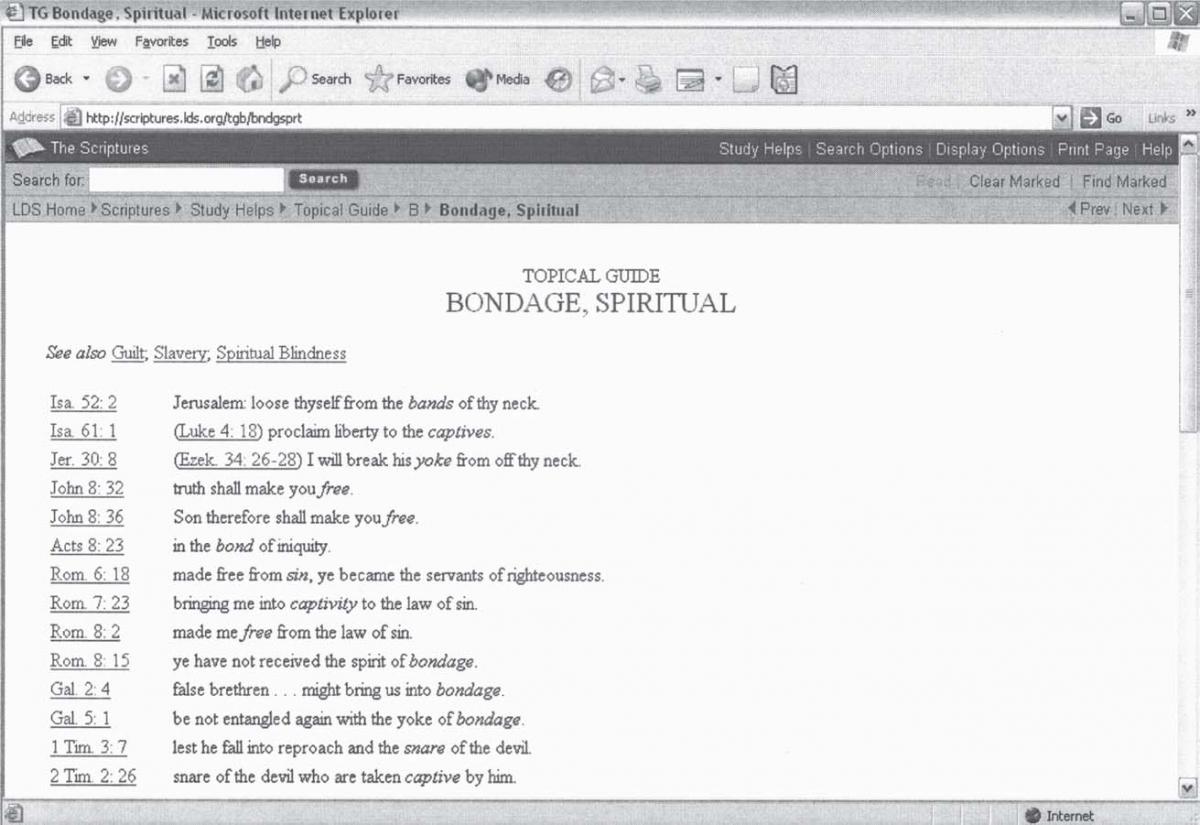
I also tell students that there can be a certain boredom barrier that must be broken in order to read, study, or search scripture. Scripture is written in an older form of English and requires greater concentration than normal reading. The language difficulty can be further complicated by the fact that some scripture seems to be written almost in a code language that requires thoughtful deciphering. That is, we must read and ponder what is to come to understand the meaning of certain words and phrases as they are used in scripture. But diligent efforts to read and study scripture relative to personal problems really help. And computer scriptures can expedite the process.
One young man who was struggling with the effects of a long-term problem seemed to be greatly helped by his diligent effort to center his scripture study on this weakness that was sapping his spiritual strength. It became clear that his addictive problem was rooted in spiritual yearnings that he attempted to satisfy using carnal, sensual means. He came to the conclusion that scripture is spiritual food—good spiritual food. And he felt it was his mainstay in overcoming a major problem in his life.
Finally, I encourage students, counseling them to go to the Topical Guide and “try the virtue of the word of God” (Alma 31:5). I tell them to see if the Spirit will speak to them as they read and study—to see if the Spirit will show them a way out of their troubles. If certain scripture Tips for Using the Scriptures on Computer 131 phrases or references seem to jump out at them, maybe that is the Spirit trying to urge them into those verses.
Both students and teachers alike will be blessed as they read the word of the Lord, whether in the computerized scriptures or otherwise. As we do so, the “still small voice” will whisper to our souls as it did to Elijah and give direction to our lives and comfort to our spirits (see 1 Kings 19:12; 1 Nephi 17:45; D&C 85:6).
